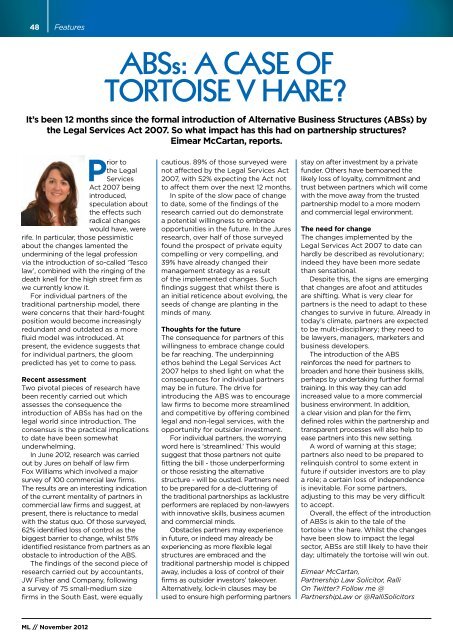Michael Napier
Michael Napier - Modern Law Magazine
Michael Napier - Modern Law Magazine
You also want an ePaper? Increase the reach of your titles
YUMPU automatically turns print PDFs into web optimized ePapers that Google loves.
48 FeaturesABSs: A case ofTortoise v Hare?It’s been 12 months since the formal introduction of Alternative Business Structures (ABSs) bythe Legal Services Act 2007. So what impact has this had on partnership structures?Eimear McCartan, reports.Prior tothe LegalServicesAct 2007 beingintroduced,speculation aboutthe effects suchradical changeswould have, wererife. In particular, those pessimisticabout the changes lamented theundermining of the legal professionvia the introduction of so-called ‘Tescolaw’, combined with the ringing of thedeath knell for the high street firm aswe currently know it.For individual partners of thetraditional partnership model, therewere concerns that their hard-foughtposition would become increasinglyredundant and outdated as a morefluid model was introduced. Atpresent, the evidence suggests thatfor individual partners, the gloompredicted has yet to come to pass.Recent assessmentTwo pivotal pieces of research havebeen recently carried out whichassesses the consequence theintroduction of ABSs has had on thelegal world since introduction. Theconsensus is the practical implicationsto date have been somewhatunderwhelming.In June 2012, research was carriedout by Jures on behalf of law firmFox Williams which involved a majorsurvey of 100 commercial law firms.The results are an interesting indicationof the current mentality of partners incommercial law firms and suggest, atpresent, there is reluctance to medalwith the status quo. Of those surveyed,62% identified loss of control as thebiggest barrier to change, whilst 51%identified resistance from partners as anobstacle to introduction of the ABS.The findings of the second piece ofresearch carried out by accountants,JW Fisher and Company, followinga survey of 75 small-medium sizefirms in the South East, were equallycautious. 89% of those surveyed werenot affected by the Legal Services Act2007, with 52% expecting the Act notto affect them over the next 12 months.In spite of the slow pace of changeto date, some of the findings of theresearch carried out do demonstratea potential willingness to embraceopportunities in the future. In the Juresresearch, over half of those surveyedfound the prospect of private equitycompelling or very compelling, and39% have already changed theirmanagement strategy as a resultof the implemented changes. Suchfindings suggest that whilst there isan initial reticence about evolving, theseeds of change are planting in theminds of many.Thoughts for the futureThe consequence for partners of thiswillingness to embrace change couldbe far reaching. The underpinningethos behind the Legal Services Act2007 helps to shed light on what theconsequences for individual partnersmay be in future. The drive forintroducing the ABS was to encouragelaw firms to become more streamlinedand competitive by offering combinedlegal and non-legal services, with theopportunity for outsider investment.For individual partners, the worryingword here is ‘streamlined.’ This wouldsuggest that those partners not quitefitting the bill - those underperformingor those resisting the alternativestructure - will be ousted. Partners needto be prepared for a de-cluttering ofthe traditional partnerships as lacklustreperformers are replaced by non-lawyerswith innovative skills, business acumenand commercial minds.Obstacles partners may experiencein future, or indeed may already beexperiencing as more flexible legalstructures are embraced and thetraditional partnership model is chippedaway, includes a loss of control of theirfirms as outsider investors’ takeover.Alternatively, lock-in clauses may beused to ensure high performing partnersstay on after investment by a privatefunder. Others have bemoaned thelikely loss of loyalty, commitment andtrust between partners which will comewith the move away from the trustedpartnership model to a more modernand commercial legal environment.The need for changeThe changes implemented by theLegal Services Act 2007 to date canhardly be described as revolutionary;indeed they have been more sedatethan sensational.Despite this, the signs are emergingthat changes are afoot and attitudesare shifting. What is very clear forpartners is the need to adapt to thesechanges to survive in future. Already intoday’s climate, partners are expectedto be multi-disciplinary; they need tobe lawyers, managers, marketers andbusiness developers.The introduction of the ABSreinforces the need for partners tobroaden and hone their business skills,perhaps by undertaking further formaltraining. In this way they can addincreased value to a more commercialbusiness environment. In addition,a clear vision and plan for the firm,defined roles within the partnership andtransparent processes will also help toease partners into this new setting.A word of warning at this stage;partners also need to be prepared torelinquish control to some extent infuture if outsider investors are to playa role; a certain loss of independenceis inevitable. For some partners,adjusting to this may be very difficultto accept.Overall, the effect of the introductionof ABSs is akin to the tale of thetortoise v the hare. Whilst the changeshave been slow to impact the legalsector, ABSs are still likely to have theirday; ultimately the tortoise will win out.Eimear McCartan,Partnership Law Solicitor, RalliOn Twitter? Follow me @PartnershipLaw or @RalliSolicitorsML // November 2012




